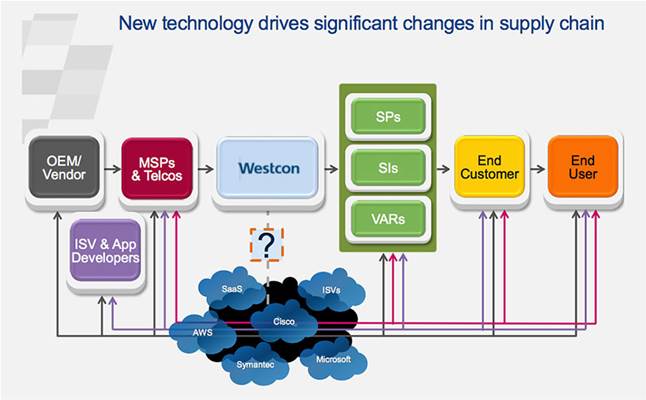Every CRN reader will know about 'channel conflict'. I wonder if it's time to retire the term. Going forward, it seems like convoluted channel relationships and 'co-opetition' will become the norm.
It used to be easy to illustrate the channel on a PowerPoint slide. Draw four boxes representing vendors, distributors, resellers and customers, with an arrow pointing in one direction to represent the flow of product.
Pity the poor executive assistant trying to design a PowerPoint for today's cloud channel, a convoluted mess looking more like a Snakes & Ladders board than a linear supply chain.
Last Friday, I had the privilege of meeting Westcon's global CEO, Dolph Westerbos, to get more of an understanding of how the distributor sees its business model in cloud.

Westerbos discussed the fast-evolving nature of channel relationships in the cloud age. Westcon is a staunchly specialised or "value-added" distributor, with just 15 key vendor partnerships. Like other disties such as Distribution Central and Nextgen Distribution, it wears its VAD status as a badge of honour. But Westerbos admitted that in the cloud era, Westcon will need to offer a broader vendor mix.
Distribution Central is the same - the company's new cloud marketplace represents a whole wave of vendors who aren't part of DC's portfolio, with more than 200 SaaS applications plus services from AWS, Microsoft Azure and IBM Softlayer.

The reseller base is changing too. At a recent event that Westcon arranged with AWS, more than 30 percent of attendees were brand-new prospects – resellers the distie had never worked with. DC's Nick Verykios said much the same thing when his company launched the DC Cloud Select marketplace in May.
But, I hear you say, none of that is really channel conflict, and you'd be right. Adding new resellers or expanding a vendor roster is standard operating procedure in the channel, though I expect the rate at which both will happen in future will leave many traditional operators gasping for breath.
No, it starts to get really messy as channel participants move up and down through the tiers. And there is plenty of that going on – everyone is more upwardly and downwardly mobile in a virtual supply chain.
As Westcon expands its suite of services up and down the channel, it creates new, "dynamic" relationships with its partners, said Westerbos. For instance, Westcon now offers its resellers a robust range of pre-sales and support services, akin to the kinds of services traditionally offered by systems integrators. Westerbos assures us that these will only ever be white-labelled, avoiding any risk of conflict with resellers. "[That's] the reason why we make all of our services available on white label; you will not see a Westcon or a Comstor consumption bill to an end customer."
We're seeing a lot more of this as distributors carve out roles beyond being a "post office and a bank". Look at Rhipe's acquisition of reseller nSynergy or the fact Avnet provides infrastructure-as-a-service out of its own data centres.
Likewise, Westcon finds itself carving out a new dynamic with the vendor community. Westcon is now a software platform vendor in its own right, following its acquisition of Verecloud, which built the billing platform underneath Westcon's Blue Sky cloud marketplace. This is the same kind of technology already provided by third-party vendors like Odin/Parallels (which is the platform behind Ingram Micro's cloud marketplace).
BlueSky also offers telemetry on cloud consumption so resellers can bill their clients according to the services they use. Westcon's No.1 vendor launched its own 'Cisco Cloud Consumption as a Service' tool this year, which will also be a white-label product sold through the channel.
Westerbos says that IT companies will need to get used to this weird and wonderful world of co-opetition. "Things have become extremely fluid in this market. It's the folks that are comfortable to partner, that can find win-win in partnerships, who are not dogmatic, who can communicate, those are the partnerships and the companies that will do well. That old thinking – 'It's our way or the highway' – that just won't work when there is so much dynamism around."
Telcos, the new channel power
This is especially true of one group who deserves a starring role on any PowerPoint slide illustrating the channel - the telcos.
The telcos have risen to prominence in the cloud for several reasons. For one, they own the pipes that link all these clouds – these data centres – together. Telcos are also well-placed because they have experience with the type of complex consumption billing that is the currency of cloud. In the cloud channel, bills will look less like your garden-variety invoice and more like my phone bill after a recent trip to the States (ideally without the bill shock that got me pulled into the CFO's office).
Few channel relationships are as complex as those that many have with Telstra. The telco is customer, partner, supplier and competitor to companies such as Westcon and Cisco, as well as many smaller IT solution providers.
Let me illustrate… and try to stay with me here.
Telstra is the biggest Australian customer for both Westcon and Cisco. Telstra is also a Cisco systems integrator, making the telco a reseller for the vendor and for its distributors. Telstra also runs its own network of data centres and has its own infrastructure-as-a-service offerings. It also hosts instances of Cisco's Intercloud as well as VMware vCloud Air. Telstra also resells these services, plus aggregates third-party IaaS from the likes of IBM Softlayer (likewise, Westcon will allow resellers to procure AWS and Azure public cloud services via its web portal – these cloud services essentially compete with Telstra's offer). And Telstra also provides the network capacity that connects all of these myriad services together.
Try illustrating all of that on a PowerPoint slide!
It's not only Telstra. "The same thing that's happening with Telstra is happening with [Dimension Data]," said Westerbos. "DiData is both a very large customer of ours, but also is becoming a vendor of ours. They are leaning out to find a larger route to market with their managed service solutions. They become an input into our portfolio that we then sell to our resellers," said Westerbos.
Westcon is currently running pilot programs with both Dimension Data and British Telecom, where the distributor becomes their path to smaller customers, revealed Westerbos. "They know how to touch the enterprise but to get to the long tail and to handle the really SMB player, this is much harder for these companies and they see us as a solution to help facilitate this.
"Will we compete against the BTs and Telstras and Dimension Datas' route to market? In some markets, I absolutely think we will," said Westerbos. "Will we become a great partner for them to reach a part of the market that they're not able to reach themselves? I absolutely think we will. This is that whole competitive flexibility, this partnering capability. It has got to become part of our DNA."
This isn't only happening in cloud
Look no further than Microsoft for a vendor that is trying to evolve while contending with backlash whenever partners perceive overreach.
The obvious example is Fast Track, the suite of free migration services that Microsoft offers clients to get them onto its cloud. Many resellers already charge for these services, hence Fast Track is a competitor. Microsoft's reasoning is that email migration is a commoditised, transactional service and that resellers should turn their attention to other, higher-value offerings, such as managed services or building their own intellectual property.
It's also clear that resellers simply aren't moving as fast as Microsoft would like. As it battles for market share against the likes of Amazon and Google, the channel simply can't get customers onto Microsoft's cloud fast enough.
But Microsoft's tangled channel relationships are not confined to the cloud. At the vendor's Worldwide Partner Conference in Orlando this month, I asked Phil Sorgen, corporate VP of Microsoft's Worldwide Partner Group, how he expected OEM device partners to respond now that Microsoft is expanding the channel for Surface, which competes with hybrid devices from many of the PC manufacturers who build Windows machines.
The official line is that Surface sits in a specific category niche. While Microsoft would like partners to push its in-house 2-in-1 for certain clients, they should position notebooks from the likes of HP, Dell and Lenovo elsewhere – i.e. there's space in the market for everyone. "Surface 3 and Surface Pro 3 don't compete in every single device category; where we don't compete, we want partners to win all the time," said Sorgen.
Very diplomatic but I'm not sure every hardware maker would agree this gels with the Surface tagline, 'The tablet that can replace your laptop'.
Therein lies the rub for Microsoft - its resellers are bound to be thrilled with the chance to start shifting Surface now that the device is available from Synnex and Ingram Micro, but no doubt the move creates some friction among its OEM partners.
Damned if you do, damned if you don't.
Which sounds like a pretty apt way to discuss channel politics in the age of the cloud.







_(11).jpg&h=142&w=230&c=1&s=1)


.jpg&w=100&c=1&s=0)
_(8).jpg&w=100&c=1&s=0)







.jpg&q=95&h=298&w=480&c=1&s=1)





